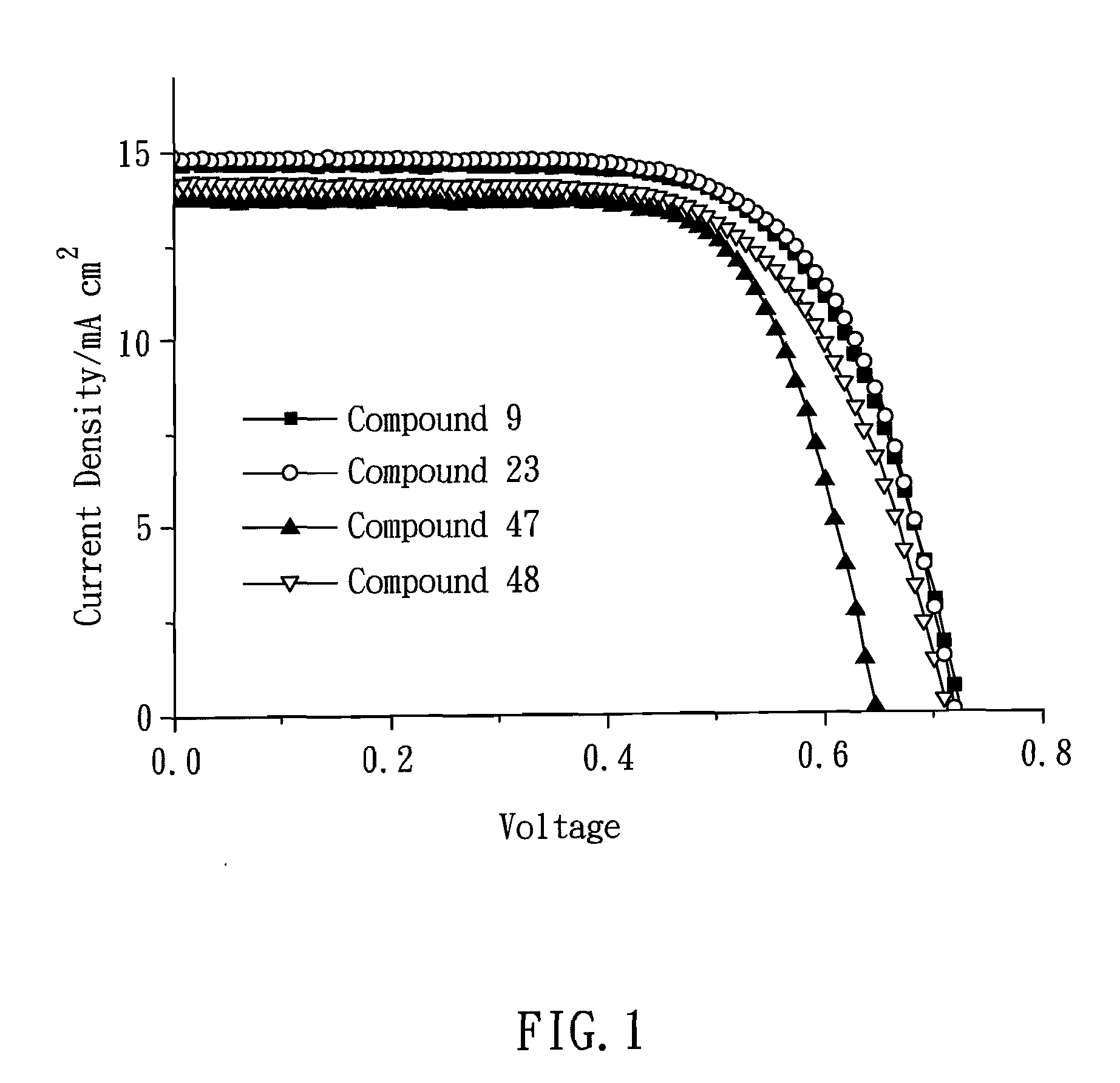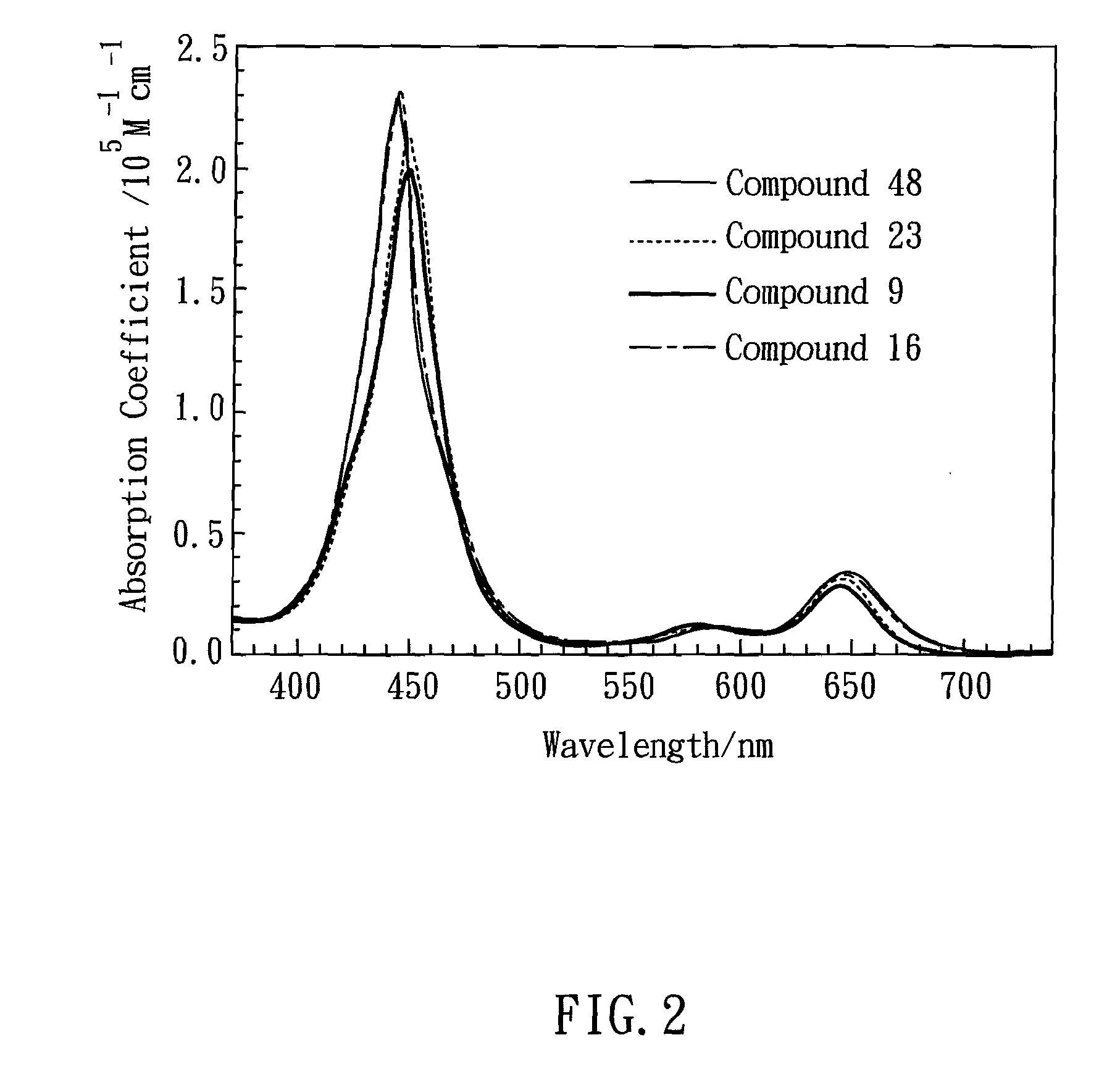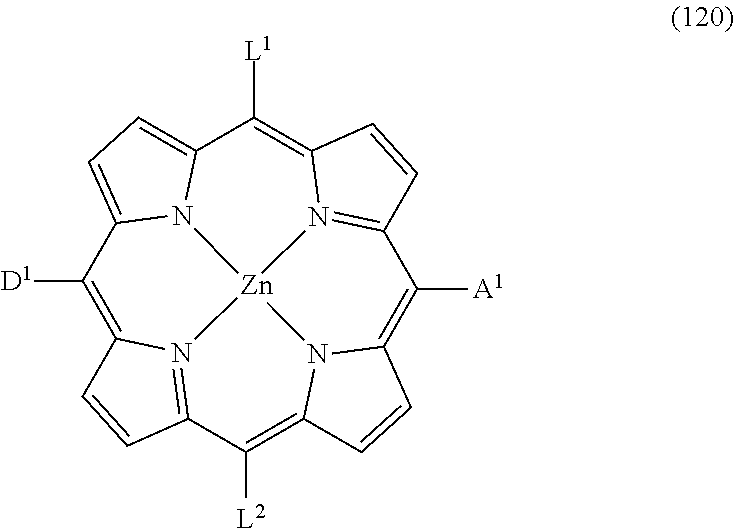Green zinc porphyrin sensitizers and their applications
a green zinc porphyrin and sensitizer technology, applied in porphines/azaporphines, chemistry apparatus and processes, organic chemistry, etc., can solve the problems of insufficient electron injection, loss of energy, and burgeoning organic dye development, so as to reduce - interaction, enhance molecular solubility, and increase stereo hindrance
- Summary
- Abstract
- Description
- Claims
- Application Information
AI Technical Summary
Benefits of technology
Problems solved by technology
Method used
Image
Examples
synthesis examples
Example 1
Synthesis of Porphyrin Compound 9
[0042]
i) 1,3-Dipentyloxy benzene, Compound 2
[0043]To a solution of resorcinol (60.0 g, 0.5 mol) dissolved in acetone (2500 mL) was added K2CO3 (24.5 g, 2.5 mol). The solution was heated and stirred under nitrogen atmosphere for 20 minutes; and then 1-bromo-3-methyl butane (251.7 mL, 2.0 mol) was introduced, to obtain a mixture. After the mixture was refluxed for six days, the mixture was filtered; and then the solvent was removed under concentration. The residue was extracted with dichloromethane; and the extracts in the organic layer were combined and dried over anhydrous MgSO4. The resulting crude product was purified by Silica Gel Column Chromatography using n-hexane, to give Compound 2 as a white liquid (113.75 g, 91%).
[0044]The white liquid was identified and assayed, and the result was shown as follows: 1H NMR (CdCl3, 400 MHz) δH=7.16 (t, J=8.0 Hz, 1H), 6.53-6.43 (m, 3H), 3.97 (t, J=6.8 Hz, 4H), 1.90-1.77 (m, 2H), 1.72-1.62 (m, 4H), 1....
example 2
Synthesis of Porphyrin Compound 16
[0061]
i) 5,15-Bis(3,5-bis(3-methylbutoxy)phenyl)porphyrin, Compound 11
[0062]A suspension of dipyrromethane (6.00 g, 41.1 mmol) and 3,5-di(isopentyloxy)benzaldehyde (11.4 g, 41.1 mmol) was added to dichloromethane (5.4 L) and stirred under nitrogen atmosphere; and then deoxidized with nitrogen for 30 minutes. Trifluoroacetic acid TFA (2.75 mL, 37.0 mmol) was charged. The reaction was carried out for 3.5 hours; and then 2,3-dichloro-5,6-dicyano-1,4-benzoquinone DDQ (13.99 g, 61.6 mmol) was added. After the reaction was performed for 1 hour, the solvents were removed under concentration to obtain a residue. The residue was purified by Silica Gel Column Chromatography using dichloromethane / n-hexane (1:1), and then was recrystallized from methanol / dichloromethane, to give Compound 11 as a purple solid (4.9 g, 30%).
[0063]The purple solid was identified and assayed, and the result was shown as follows: 1H NMR (CdCl3, 400 MHz) δH=10.32 (d, J=12.8 Hz, 2H), 9...
example 3
Synthesis of Porphyrin Compound 23
[0077]
[0078]Compound 23 was prepared in the manner of the preparation for Compound 16 described above.
i) (10,20-Bis(2,6-dioctyloxyphenyl)porphyrinato)Zinc(II), Compound 18
[0079]A mixture of dipyrromethane (6.04 g, 41.4 mmol), 2,6-bis(octyloxy)benzaldehyde (15.0 g, 41.4 mmol) was added to dichloromethane (5.40 L), stirred and was deoxidized with nitrogen for 30 minutes. To the solution was charged TFA (2.75 mL) and reacted for 3.5 hours under nitrogen atmosphere. After charging 2,3-dichloro-5,6-dicyano-1,4-benzoquinone DDQ (14.00 g, 61.7 mmol), the reaction was performed for an additional 1 hour. The solvent was removed under concentration to obtain a residue. The residue was purified by Silica Gel Column Chromatography using dichloromethane / n-hexane (1:2); and recrystallized from methanol / dichloromethane, to give Compound 18 as a purple solid (6.25 g, 30.7%).
[0080]Compound 18 was identified and assayed, and the result was shown as follows: 1H NMR (C...
PUM
| Property | Measurement | Unit |
|---|---|---|
| Transparency | aaaaa | aaaaa |
| Photosensitivity | aaaaa | aaaaa |
| Power conversion efficiency | aaaaa | aaaaa |
Abstract
Description
Claims
Application Information
 Login to View More
Login to View More - R&D
- Intellectual Property
- Life Sciences
- Materials
- Tech Scout
- Unparalleled Data Quality
- Higher Quality Content
- 60% Fewer Hallucinations
Browse by: Latest US Patents, China's latest patents, Technical Efficacy Thesaurus, Application Domain, Technology Topic, Popular Technical Reports.
© 2025 PatSnap. All rights reserved.Legal|Privacy policy|Modern Slavery Act Transparency Statement|Sitemap|About US| Contact US: help@patsnap.com



